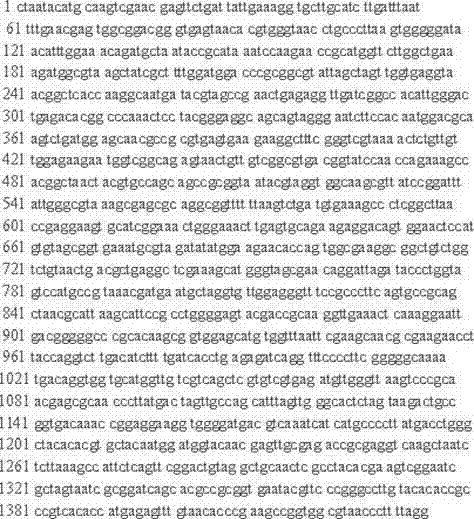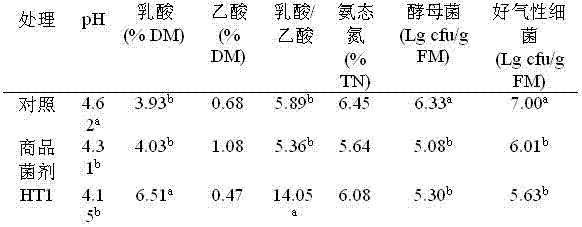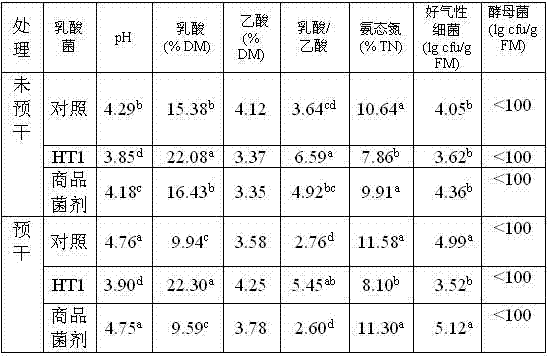High temperature resistant lactic acid strain ht1 and its application in preparing silage
A technology of silage and lactic acid bacteria, which is applied to the preservation method, application, and animal feed of animal feed materials. It can solve problems such as strong corrosion, unsafe operation, and failure to consider high temperature conditions, so as to improve fermentation quality and fermentation. The effect of quality and great application value
- Summary
- Abstract
- Description
- Claims
- Application Information
AI Technical Summary
Problems solved by technology
Method used
Image
Examples
Embodiment 1
[0022] Embodiment 1: screening high temperature resistant good lactic acid bacteria
[0023] Isolate 90 strains of lactic acid bacteria from Kinggrass, Stylophyllum, corn, wild rice and other materials, carry out Gram staining and cell shape observation, and according to the growth temperature (10, 15, 20, 25, 30, 35, 40, 45 , 50°C) and growth pH (3.5, 3.75, 4.0, 4.5, 5.0, 5.5, 6.0, 6.5, 7.0, 7.5, 8.0, 8.5, 9.0) and other experiments screened out lactic acid bacteria HT1 with high temperature resistance, acid resistance and fast growth rate. The results showed that the HT1 strain is a Gram-positive, homofermentative bacillus that can grow at 50°C and pH 3.75, has strong resistance to high temperature and acid, and can ferment most sugars (Table 1).
[0024] Table 1 Characteristics of strain HT1
[0025]
[0026] -: no growth; ±: weak growth; +: growth; ++: good growth.
[0027] Lactic acid bacteria HT1 The physiological and biochemical tests, culture medium ...
Embodiment 2
[0036] Embodiment 2: the identification of lactic acid bacteria
[0037] The strain was cultured overnight at 37°C in 5 mL of MRS medium, the bacterial solution was transferred to a 1.5 mL centrifuge tube, and the bacteria were collected by centrifugation at 10,000 rpm / min for 3 to 5 min, and TE 0.1 (10 mmol / L Tris–HCl, 0.1 mmol / L EDTA, pH 8.0) was washed twice, and DNA was extracted with TIANamp Bacteria DNA Kit (TIANGEN BIOTECH CO., LTD, Beijing, China) and detected at OD600 nm its absorbance value. Then, carry out PCR amplification, the amplification primers of 16S rDNA are 25f (5`-AAC TGA AGA GTT TGA TCC TGG CTC-3`) and 1492r (5`-TAC GGC TAC CTT GTT ACG ACT-3`), RCR The reaction range is 95°C (5 min) - 94°C (30 s) - 55°C (1 min) -72°C (1.5 min) -72°C (10 min), of which 94°C (30 s) - 55°C (1 min) )-72°C (1.5 min) reaction cycle 30 times. The amplified product was sent to Boshang Biotechnology Co., Ltd. (China) for sequencing, and the results were compared on the NCBI g...
Embodiment 3
[0038] Example 3: Effect of adding to silage
[0039] Silage addition experiments were carried out with lightly predried (predried refers to drying to reduce moisture content) and non-predried ryegrass as materials. Cut ryegrass to 1 cm to 2 cm, mix evenly, and add about 1.0×10 strain HT1 per kg of fresh material 8 indivual. The ryegrass feed added with the strain HT1 was put into 30 cm×20 cm polyethylene silage bags, 6 bags for each treatment, 3 bags were stored at 45°C, and 3 bags were stored at 15°C, each bag was about 200 g. (SINBO Vacuum Sealer, Hong Tai Home Electrical Appliance Co. Ltd.) was pumped, sealed, and stored at 45°C for 30 days.
[0040] project undried ryegrass pre-dried ryegrass rice Dry matter (%) 16.37 30.03 50.73 Crude ash (% DM) 9.86 10.28 10.04 Soluble carbohydrates (% DM) 13.7 12.39 11.16 Crude protein (% DM) 14.36 14.87 6.19 Crude fat (% DM) 4.13 3.12 2.11 Crude fiber (% DM) — — — ...
PUM
 Login to View More
Login to View More Abstract
Description
Claims
Application Information
 Login to View More
Login to View More - R&D
- Intellectual Property
- Life Sciences
- Materials
- Tech Scout
- Unparalleled Data Quality
- Higher Quality Content
- 60% Fewer Hallucinations
Browse by: Latest US Patents, China's latest patents, Technical Efficacy Thesaurus, Application Domain, Technology Topic, Popular Technical Reports.
© 2025 PatSnap. All rights reserved.Legal|Privacy policy|Modern Slavery Act Transparency Statement|Sitemap|About US| Contact US: help@patsnap.com



